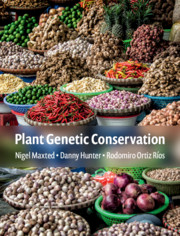Book contents
- Frontmatter
- Frontispiece
- Contents
- Foreword
- Preface
- Acknowledgements
- Part I Introduction
- Part II Scientific Background
- Part III Conservation Practice
- Part IV Plant Exploitation
- 14 Plant Uses
- 15 Germplasm Evaluation
- 16 Plant Breeding
- 17 Participatory Plant Breeding
- 18 Conservation Data Management
- Acronyms and Abbreviations
- Glossary
- References
- Index
- Plate section
18 - Conservation Data Management
from Part IV - Plant Exploitation
Published online by Cambridge University Press: 05 September 2020
- Frontmatter
- Frontispiece
- Contents
- Foreword
- Preface
- Acknowledgements
- Part I Introduction
- Part II Scientific Background
- Part III Conservation Practice
- Part IV Plant Exploitation
- 14 Plant Uses
- 15 Germplasm Evaluation
- 16 Plant Breeding
- 17 Participatory Plant Breeding
- 18 Conservation Data Management
- Acronyms and Abbreviations
- Glossary
- References
- Index
- Plate section
Summary
Data management is key to conservation and this includes: the types of data, how data are recorded, data standardization and conservation data management. The main sources of data are passport (provenance) and ecogeographic data, characterization and evaluation data, and management or curatorial data, each of these data are collated and managed by conservationists. Although associated with these data management types, three fundamentally important pieces of data are pivotal. The accession number (or unique identifier), the scientific name of the taxon being conserved and the date of the conservation intervention (e.g. seed collection or population monitoring date). Often today data management is assisted by using a conservation data management system (e.g. GRIN Global) to improve efficiency and help enforce data standardization. Further data management is assisted by use of data collection templates or accession / population descriptors. Much of these data are then made available to the user community via web-based platforms such as EURISCO or GBIF. The importance of access to and ownership of the various kinds of data is emphasized as fundamental to good data management practice.
Keywords
- Type
- Chapter
- Information
- Plant Genetic Conservation , pp. 492 - 517Publisher: Cambridge University PressPrint publication year: 2020

